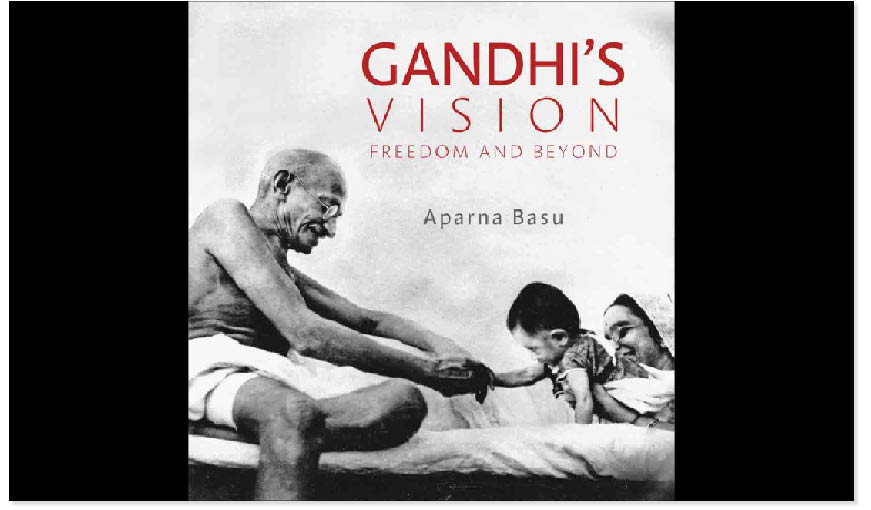In her last book, the late Aparna Basu wrote about Mahatma Gandhi’s revolutionary ideas about politics and society which continue to resonate more than half a century after his death.
The primary aim of all education, he said, is or should be character building. In a letter to his son Manilal, written from Volksrust prison in 1909, Gandhi wrote, “Education does not mean a knowledge of letters but it means character building.” He distinguished between literacy and knowledge and held that literacy in itself was no education. Development of human personality was far more significant than the accumulation of intellectual tools and knowledge. He envisioned true education coming about primarily through a particular pattern of life in a community and not merely through formal instruction in schools. Schools should prepare citizens of a society—a non-violent society—and teach children to live on the basis of co-operation, truth and ahimsa.
The essential tenets of education as propounded by Gandhi can be summed up as follows:
Education must serve the nation’s needs consistent with the philosophy of freedom, truth and non-violence.
Equality of all religions and all men.

Equal importance to intellectual training and manual work, which should be socially useful and productive.
Mother tongue as the medium of instruction at all levels along with the compulsory teaching of Hindi.
The curricula and other arrangements should aim at serving the needs of villagers.
It was a basic principle of all Gandhian institutions that teachers should regard untouchability as a blot on Hindu society and should strive for its removal and should never exclude a boy or girl for reasons of his being an untouchable, nor treat him or her differently after admission.
Manual work was an integral part of Gandhian education. There is no point, he used to say, in developing the brain only. One has to develop one’s brain through one’s hands.
Gandhi had been engaged in the work of rural reconstruction, harijan uplift and political regeneration and therefore, his fingers were constantly on the pulse of the common people. He realised that unless education was given a new orientation, it would not be possible to build the social order that he cherished. He placed before the nation a scheme which he had been evolving for 40 years—a scheme popularly known as the Wardha Scheme of Education, which he called “Nayee Talim” or New Education. He defined it as education for life and through life.
Gandhi’s educational ideas grew out of his experiments in education with his family and in his ashrams in South Africa and India before they were formulated and publicly announced. By education he meant an all-round drawing out of the best in the child and man—body, mind and spirit.

“That education alone is of value,” he said, “which draws out the faculties of a student so as to enable him or her to solve correctly the problems of life in every department.”
“Nayee Talim means teaching through craft. That basic craft has to be selected in the light of the conditions and produce of the region.”
According to him, self-reliance was the most important characteristic of Nayee Talim. The knowledge that this system imparted could not be had from books. It was from nature that this knowledge had to be obtained. “Knowledge directly derived from anything was much better than knowledge derived through a written lesson or through symbols. That was the essential basis of Nayee Talim.”
Basic education discarded bookish learning and aimed at an all-round development of the child so that he could become a useful and productive member of the society. In his last talk on Nayee Talim on 14 December 1947, Gandhi said, “Basic education is generally interpreted as education through craft. This is true to a certain extent, but this is not the whole truth. The roots of Nayee Talim go deeper. It is based on truth and non-violence in individual and collective life.”
The Wardha scheme left out teaching of religion because Gandhi held that religions
Independent India abandoned Gandhi’s ideas on education. But today, once again, we are emphasising the importance of skill development and vocational education. Looking at the national scene, with growing violence, rape, crimes against women, dalits and minorities, increasing individual and corporate corruption, and lack of moral standards, one realises why Gandhi placed so much importance on character building as crucial for the nation building.
LANGUAGE OF LEARNING
“Our system of education has three aspects. It leads to the development of the mind, body and the soul.”
JOY OF SHARING
Gandhi’s life was one of constant experimentation to know the truth and to live it according to his light. This light never ceased to illuminate his awareness and to spread the luminosity among those with whom and for whom he worked. He had the gift to learn and grow with experience of events in daily life and the principles he held, evolved out of his experiences and experiments.
Gandhi’s idea of the resolution of conflicts not by violent struggles between classes or castes or communities, but by peaceful, non-violent means, of removing poverty and inequality, of the “small is beautiful”, of preserving the environment, of honesty and probity in public life, of his belief in pluralism, of an open society and an open polity—are all extremely relevant today. The Prophet would have the vision of the Poet, of an India:
“Where the mind is without fear and the head is held high;Where knowledge is free, Where the world has not been broken up into fragments by narrow domestic walls; Where tireless striving stretches its arms towards perfection; Where the clear stream of reason has not lost its way into the dreary desert sand of dead habit; Where the mind is led forward by thee into ever widening thought and action—Into that heaven of freedom my father, let my country awake.”
Excerpted with permission from ‘Gandhi’s Vision: Freedom and Beyond’, by Aparna Basu, published by Niyogi Books

